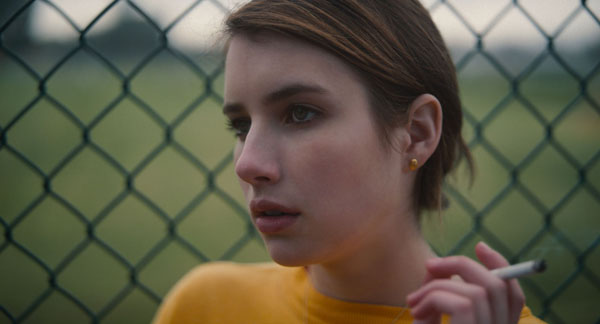“Gia Coppola proves to have quite the eye, if not quite the natural storytelling instinct of her cinematic kin, serving up a remarkably assured feature debut with Palo Alto,” begins Variety‘s Peter Debruge. “Drawn from James Franco’s short story collection, which consists mostly of driving drunk, smoking weed and deflowering virgins, this group portrait of disaffected Northern California teens goes to impressive lengths to develop the characters and shape their experience into something meaningful without ever quite cracking how its various vignettes should function as a whole.”
“And if the brickbats weren’t going to be out for her purely on the basis of her heritage,” writes Oliver Lyttelton at the Playlist, “the film is led by two other scions of big stars in the shape of Emma Roberts and, in his first acting role, Jack ‘son of Val’ Kilmer.” But “while the film isn’t as fully formed a debut as, say, Auntie Sofia’s The Virgin Suicides, it certainly suggests that plenty of directing talent ended up in Gia’s DNA.” This “ensemble teen drama focusing, in family form, on a group of privileged white kids” is “pretty familiar stuff, indistinguishable on the page from a dozen other teen movies—it’s Fast Times at Ridgemont High… by way of the airline edit of Larry Clark’s Kids…. But like the recent The Perks of Being a Wallflower and The Spectacular Now, it’s all about the execution, and Coppola Jr. executes things pretty well.”
For the Hollywood Reporter‘s Todd McCarthy, Palo Alto is the “best feature film directed by someone named Coppola in a number of years.” It “deals with such familiar hot-button teen issues as suicide, drugs, drinking and random sex, but from the coolly observational perspective of a curious artist rather than from a hormonal or sociological point of view; creatively, it’s almost the polar opposite of something deliberately confronting and self-consciously provocative like Harmony Korine’s Spring Breakers…. Along with the allure of Autumn Cheyenne Durald’s cinematography, the soundtrack is another major asset here, with songs and musical samplings having been layered and moved in and out in effective ways. Veteran sound designer Richard Beggs no doubt played a significant role in fashioning the complex soundtrack.”
“Palo Alto ultimately strains to justify all its moving parts,” finds Indiewire‘s Eric Kohn, who’s nevertheless impressed enough to declare that the film “clearly establishes a new filmmaker to watch.”
The Film Society of Lincoln Center’s Eugene Hernandez strolled a few moments with Coppola at Telluride: “Explaining that her own experiences mirrored those depicted in the movie, Coppola added that she hoped to capture an authenticity that emerged from the way the kids related to each other on set. The actors lived together in a house, her mom cooking for the kids during the 30-day shoot.”
Having screened at Telluride and in the Orizzonti section in Venice, Palo Alto‘s headed to Toronto‘s Discovery program.
Updates: “Coppola is clearly going for the dreamy lyricism that characterizes her aunt Sofia’s work,” writes Jon Frosch for the Atlantic. “But Palo Alto is an example of how to turn been-there-done-that material into something luminous.”
“At its over-stylized worst, Palo Alto resembles a partially animated American Apparel photoshoot,” writes Ashley Clark for Filmmaker, “but for the majority of its running time it’s a keenly observed, humane group portrait which knits together the disparate tales of its source material into a neat, Raymond Carver-lite quilt. It wears its influences (Gus Van Sant, Bret Easton Ellis, Jonathan Kaplan’s classic Over the Edge) on its sleeve, and has little new to say, but possesses a winning sense of humor and fine performances from an impressive young cast.”
Update, 9/8: David Acacia for the International Cinephile Society: “Overall, this is a polished and successful first feature, and many elements of the film already feel instantly iconic and essential to a canon of youth-driven, pop culture-oriented cinema.”
Update, 9/14: “Cigarette smoke rises from the Vatican chimney—a new Coppola has been chosen!” 8.7/10 from David Ehrlich at Film.com: “Essentially Fast Times at Raymond Carver High, a tight and teen-sized Short Cuts, Palo Alto begins with a blast of frustrated energy, the prologue soaked in such sensitive and assuredly adolescent nowhere, California verve that you’re helpless to accept that the film exists for reasons other than the fact that it can.”
Update, 9/17: The Boston Globe‘s Ty Burr: “Palo Alto is almost eerily good at defining the great divide between the way teenagers experience the world and the way their parents do, but it does leave me wondering (as many movies in this genre do): If all the kids are damaged angels and all the adults are monsters, where and when and how does one become the other? Maybe someone should make a movie about that.”
Update, 11/16: “You don’t inherit the film’s ineffably elegant technique—a precociously sure-handed feel for light, performance, and time.” Nicolas Rapold in Film Comment: “The locale of Palo Alto, as shot by cinematographer Autumn Cheyenne Durald, comes across beautifully under cool, often autumnal light. But the soft glow and the chill soundtrack don’t set the characters apart in another realm—these ordinary teenagers feel palpably real, with access to pools, cars, and pot, but not fixed on a predetermined path. It’s a formidable debut that shows amazing promise, and care.”
Updates, 4/25: In Palo Alto, Jesse Cataldo, writing at Slant, finds “the same generalized view of suburbia that’s been depicted regularly since the mid ’60s, as a place with a toxic dedication to keeping up appearances, beneath which fractured people live out incomplete existences, all of them quietly desperate for something more. There’s not much novelty in this conception, nor in the film’s rote set of characters—the burnouts and virgins and various other half-formed personalities—compiled piecemeal from previous suburban sagas.”
Cara Buckley talks with Coppola for the New York Times, while, for Indiewire, Paula Bernstein talks with cinematographer Autumn Durald.
Update, 5/3: “Whisper-thin, as delicately boned as a bird and with honeyed hair and dark chocolate eyes, Ms. Coppola is reserved and private in person, evoking her aunt Sofia.” Cara Buckley profiles her for the New York Times. And Daniel D’Addrario talks with her for Salon. At Buzzfeed, Alison Willmore talks with Emma Roberts.
Updates, 5/7: Melissa Anderson, writing for Artforum: “A strawberry shake splattering on the ground, brightly colored fridge magnets spelling out COCK 4 DAYZ, a babysitter and her charge donning cat and tiger masks: Many images in Gia Coppola’s Palo Alto seize the viewer’s attention even if characters, ideas, and point of view prove elusive…. Are kids in the wealthier ZIP codes really this dull and opaque? Much lower on the socioeconomic scale are the teen protagonists of Terri and Pariah, both from 2011, and those of It Felt Like Love, released in March, and the upcoming Boyhood—all films that honor their subjects by paying close attention to them.”
“For all the bad behavior on display (teacher-student seduction, property destruction, copious drug and alcohol use), Palo Alto doesn’t play like a ticking time bomb,” finds Time Out New York‘s Keith Uhlich. “Instead, the film is empathetic to a fault, seeing beauty in each character’s struggle even if it can’t always sell them as flesh- and-blood human beings.”
Most reviewers are immediately reminded of The Virgin Suicides, including the Dissolve‘s Scott Tobias: “The mimicry is so pronounced that it’s hard to locate a distinct, original sensibility beyond the film’s apparent influences. But talented young directors often need time to develop into singular ones, and there’s value in Coppola’s sensual, always-sympathetic feel for lost adolescents.”
“And though it’s hard to say from a debut whether a director has a gift for guiding actors, every performer here is so fully in tune with one another and the material that it’s safe to surmise Coppola may have the touch,” adds Stephanie Zacharek in the Voice. “Kilmer and Roberts are wondrous.”
“I suspect that part of what made Lost in Translation soar as it did was how closely its surreal lives aligned with the director’s,” writes Chris Norris for Film Comment, “how its specificity let it breathe universal air. A quick scan of Gia’s star-crossed bio indicates that she knows a far richer, sadder world than anything in the angsty-affluent teenage film canon. Raised in Los Angeles and points north, Coppola may, like her aunt, regard traffic the way Wordsworth regarded daffodils, since the most promising visual poetry in Palo Alto is the kind that begins and ends Sofia’s Somewhere—vehicular renditions of psychic and existential states.”
Kate Branch talks with Roberts for BlackBook.
Updates, 5/8: Coppola’s “work here exhibits an identity of its own, characterized by purposeful close-ups and slow ’70s-flavored zooms,” writes Ignatiy Vishnevetsky at the AV Club. “Her sense of visual composition, which betrays a Gus Van Sant influence, ensures that Palo Alto remains interesting to look at even as it runs out of ideas. Not that there are many.”
“Coppola seems to have sensed the slightness at the heart of these stories,” writes Tom Shone for the Guardian, “and, with that lack of humbug that is the prerogative of novice directors, has not done anything to cover for it. Someone with more ego at stake might have been tempted to make more of a ‘statement.’ But the slightness is what’s interesting about these lives, which have been limned gracefully by the 27-year-old director.”
Salon‘s Andrew O’Hehir: “By moving Franco’s stories from the past into the present (his teen years in Palo Alto would have been the mid-‘90s), but without becoming unduly distracted by technology and social media, Coppola sets Palo Alto free from obligatory nostalgia, from the period hit songs so often inflicted in these kinds of movies. But she also doesn’t try to insist, in this lovely, textured, memorable debut film, that there’s anything especially contemporary about long nights of teenage vandalism, abstruse philosophical debates, misguided beverage combinations and ill-advised coupling. Those episodes of dark magic always seem momentous, meaningful and entirely unrepeatable when we’re personally involved, but other kids will come along to do it all over again the next year.”
New interviews with Coppola: David Ehrlich (Dissolve) and Emma Myers (Film Comment).
Updates, 5/9: Coppola “does a lot right here, including coaxing out sympathetic characters who, in other hands, could have been ciphers,” finds the New York Times‘ Manohla Dargis. “Her quiet, attentive filmmaking goes a long way toward distinguishing the sometimes generic material… What tethers the movie and especially April and Teddy is how Ms. Coppola captures that exquisitely tender, moving moment between fragile, self-interested youth and tentatively more outwardly aware adulthood, a coming into consciousness that she expresses through their broken sentences, diverted glances and abrupt turns.”
“The greatest respect the film shows its young characters is giving them the benefit of the doubt—the acknowledgement that bad behavior doesn’t necessarily make them bad people.” Tomas Hachard for NPR: “But Coppola also knows better than to let them off the hook completely…. As a coming-of-age story, Palo Alto doesn’t take the loss of innocence lightly; on the contrary, it’s a film about the desperate need to keep some of it intact.”
Lisa Rosman at Word & Film: “‘Blur’ is the name of the game here: blurs of booze and smoke (even the adults are perennially stoned). Blurs of bleached-out color on sunny days. Blurs of neon lights blazing up night skies…. If all this still feels aimless, it is Dickensian compared to the affectless sketches that comprise Franco’s eponymously titled short story collection.”
“Palo Alto is not like other, current films about teens, films that ache with hopelessness and alienating nihilism,” writes Sheila O’Malley at RogerEbert.com. “Palo Alto sees the sweetness that is there, too, struggling to express itself, and to survive.”
Update, 5/12: Jonathan Marlow talks with Coppola here in Keyframe.
2013 Indexes: Venice, Telluride, and Toronto. For news and tips throughout the day every day, follow @KeyframeDaily on Twitter and/or the RSS feed. Get Keyframe Daily in your inbox by signing in at fandor.com/daily.





